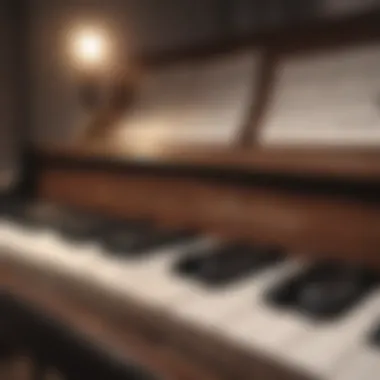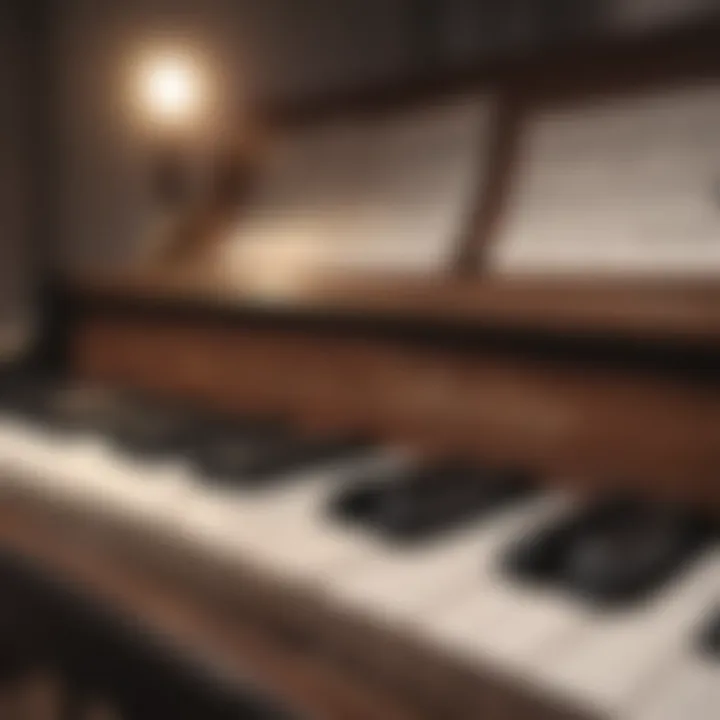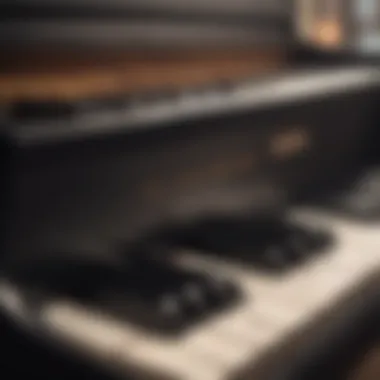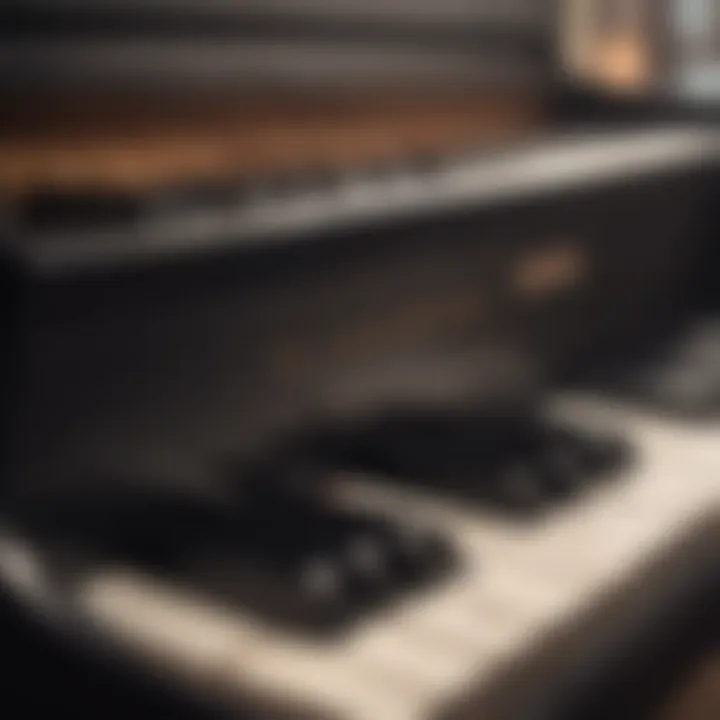Mastering 'Chasing Cars' on Piano: A Detailed Guide


Intro
This guide takes you on a journey through the beautiful melody of 'Chasing Cars,' a song that resonates not only with its listeners but also presents a wonderful opportunity for pianists to express their emotions. While the song itself may seem simple on the surface, it contains layers of depth that allow for a variety of interpretations, making it a popular choice for both seasoned musicians and beginners.
In the following sections, we will explore the artist who crafted this memorable piece, dissect its lyrics and musical composition, and provide practical tips for bringing this song to life on the piano. Understanding the emotional weight of the song, the techniques for executing it well, and the nuances of its melody will enable you to connect with the music on a deeper level.
Whether you're aiming to evoke heartfelt emotion in your performance or simply looking to learn a new tune, this comprehensive guide is designed to aid you in every step of your journey with 'Chasing Cars.'
Artist Profile
Biography and Background
'Chasing Cars' is a signature track from the rock band Snow Patrol, formed in 1994 in Dundee, Scotland. The band's blend of alternative rock and pop has garnered them a dedicated following. Lead singer Gary Lightbody, known for his distinctive voice and introspective lyrics, is often considered the driving force behind the band's sound. Lightbody’s own life experiences heavily influence his songwriting, striking chords that many listeners can relate to.
Throughout their career, Snow Patrol has experienced various peaks and valleys, but the sheer emotionality present in their music has allowed them to remain relevant. The release of 'Eyes Open' in 2006, featuring 'Chasing Cars,' marked a significant moment for the band, propelling them to mainstream success.
Major Influences and Inspirations
The songwriting of Snow Patrol draws from a myriad of influences. Bands like Radiohead and U2 are often cited as inspirations, particularly in terms of lyrical narrative and sound texture. However, the lyrical landscape painted by Lightbody reflects his personal encounters—love, loss, and longing—which resonate deeply and make the music accessible.
Lightbody’s honest perspective allows listeners to see their own stories within the lyrics. The band often captures a sense of yearning that feels intrinsic—creating songs that invite you to explore your own emotions.
Song Analysis
Theme and Lyrics Breakdown
At its core, 'Chasing Cars' is a love song enveloped in longing and simplicity. The lyrics convey a desire for connection and an escape from the chaos of the world. Phrases like “If I lay here, if I just lay here” evoke a sense of vulnerability, inviting listeners to reflect on their own relationships and moments of stillness.
"The song captures that rare moment where time seems to suspend, reminding us that sometimes just being present is enough."
The repetitive nature of the song's structure mirrors the essence of the feelings described—an echo of emotions that is relatable. Each line builds upon the last, creating a tapestry of sentiment that resonates with the collective human experience.
Instrumentation and Composition
Musically, 'Chasing Cars' showcases a delicate balance between melody and harmony. Starting with a soft, contemplative piano, the tone gradually evolves.
Here are a few standout features of its composition:
- Melodic Structure: The melody is straightforward yet effective, allowing the emotional weight of the lyrics to take center stage.
- Chords and Progressions: Often, simple chord progressions create a sense of familiarity, which invites the player to focus on feel rather than complex techniques.
- Instrumentation: While the song primarily relies on soft piano and orchestral elements, the gradual crescendo adds layers that enhance its emotional intensity.
For those learning to play, understanding these key elements can help guide your interpretation.
As you prepare to tackle 'Chasing Cars' on the piano, remember to approach it with an open heart, focusing on the emotions you wish to convey. Each note offers a chance for connection not only to the piece but to your audience as well.
Foreword to 'Chasing Cars'
As we dive into the heart of this piece, it's crucial to understand why 'Chasing Cars' holds a unique place within the realm of contemporary music. Not simply another pop tune, this song resonates strongly due to its emotional depth and simple yet profound melodic structure. The importance of exploring this song on piano extends beyond just learning the notes; it’s about expressing feelings and allowing the music to speak.
Many musicians and enthusiasts find themselves drawn to 'Chasing Cars' not just for its catchy melody but also for what it represents. The song captures a sense of longing, yearning, and a desire for connection, themes that are universal and relatable. By playing this piece on the piano, one can experience its emotional nuances intimately.
Overview of the Song
'Chasing Cars', crafted by the band Snow Patrol, has a special allure. The piece combines simplicity with profound lyrical meaning. With its repetitive structure and lush arrangements, it invites players to explore emotive dynamics. The song encapsulates a feeling of serenity, making it ideal for expression through the piano. The slow tempo and gentle chord progressions allow for a reflective playing style, which is instrumental in conveying its deeper messages.
- Structure: Often structured around a few central chords, the song allows pianists to focus on dynamics and expression rather than technical complexities.
- Impact: Many find themselves holding onto each note, repeating sections to fully appreciate the soft build-up and release of tension within the music.
Artist Background
Understanding the roots of 'Chasing Cars' provides valuable insight into its creation. Snow Patrol, originally from Northern Ireland and Scotland, formed in the late ’90s. The band was part of the post-Britpop wave which carried the sound of indie rock into the mainstream. Lead singer Gary Lightbody's poignant songwriting often pulls from personal experiences, creating a connection with listeners.
This band’s breakthrough came in the mid-2000s, and they steadily built a reputation for crafting heartfelt music. 'Chasing Cars', released in 2006, marked a turning point; its appearance in popular culture, including major television shows, propelled it into the hearts of many.
Knowing the background helps pianists appreciate the song’s subtleties. The heartfelt lyrics and emotive melodies reflect not just the band's creativity, but also a deep communal response that beckons musicians to share their interpretations. This piece truly is a blend of personal sentiment and universal themes that can profoundly resonate with anyone who takes the time to play it.


Understanding the Music
Grasping the essence of the music is fundamental for any pianist attempting to master the piece 'Chasing Cars.' It’s not merely about hitting the right keys; it’s about embodying the emotional weight of the song. When a pianist understands the underlying structure, they can transform notes into a captivating narrative. Comprehension of musical elements enhances the ability to interpret and perform with authenticity while ensuring that the emotional heart of the piece isn’t lost in translation.
Structure of the Song
Upon examining the song's structure, three main components emerge as essential for any pianist—verses, choruses, and bridges. Each part plays a unique role in building the song’s emotional landscape.
Verse Analysis
The verses of 'Chasing Cars' lay down the foundation of the song’s story, presenting the core themes in a simple yet profound manner. Each verse unfolds a glimpse into the emotional undercurrents, narrating a tale of longing and connection. This section is particularly noteworthy because of its lyrical clarity; it gives the pianist a firm anchor to build their interpretation around.
One key characteristic of the verses is their simplicity combined with rich emotional backdrop, making them a beneficial choice for learners focused on developing expressive playing. The unique feature of the verses lies in their steady rhythm and harmony, allowing performers to focus on dynamics without getting overwhelmed by technical complexities. On the flip side, the straightforwardness can make it seem less engaging for advanced players who might crave intricate challenges.
Chorus Examination
The chorus elevates the emotional stakes, packing a punch that resonates with listeners. This section thrives on repetition and a catchy melody, making it particularly memorable. The key characteristic of the chorus is its anthemic quality; it balloons with emotion. For this article, the chorus serves as an excellent point of focus for pianists, drawing on its dynamic shifts that can be interpreted in various ways.
Its unique feature is the contrast it provides with the verses, allowing for a broader range of emotional expression. However, this contrast can also lead to pitfalls if a pianist fails to find the balance—playing it too loudly might detract from the introspective nature of the verses.
Bridge Insights
A striking aspect of the bridge is its transitional nature—it serves as a bridge not just in the musical sense but also emotionally. This section introduces new melodies and harmonies while seamlessly connecting back to the chorus. The key characteristic here is its ability to shift the emotional focus, creating a sense of buildup before the return to the more familiar chorus.
The bridge’s distinctive feature lies in its role to break the routine established by the verses and choruses, offering both excitement and tension. In this piece, it can be a double-edged sword for musicians; while it provides an opportunity for creativity, it also requires careful attention to maintain the overall feel of the song.
Harmonic Progressions
Harmonic progressions in 'Chasing Cars' dictate the flow and mood of the song, providing a backdrop against which melodies unfold. Understanding these progressions helps pianists appreciate how different chords create emotional dynamics and support the lyrical narrative, thus lending depth to their performance. Whether you're a novice or seasoned musician, becoming familiar with these progressions is crucial to mastering the piece and interpreting it in your unique way.
Technical Preparations
Before diving into the beautiful melody of "Chasing Cars," it's crucial to address the technical preparations that lay the groundwork for producing a polished performance. Think of this stage as assembling the tools needed before embarking on a DIY project. Proper preparations can significantly enhance your playing experience and outcome, safeguarding against frustrations that may arise from an inadequate setup.
Selecting the Right Piano
Choosing the right piano is akin to finding the perfect pair of shoes for a big event; it can make all the difference. Whether you opt for an acoustic piano or a digital one, each comes with its unique advantages. Acoustic pianos offer rich, resonant sounds that can convey deep emotion. On the other hand, digital pianos provide versatility; oftentimes, they come equipped with various sound settings, allowing you to customize your playing experience. In essence, pick the one that resonates with your style, your budget, and your available space.
Setting Up the Environment
A conducive environment for practice and performance can ramp up the quality of your output. Paying attention to lighting and acoustic conditions can help create a space where creativity thrives.
Lighting Conditions
Light can affect your mood and focus. Using natural light is often a good approach, as it brings a touch of warmth and can improve your overall comfort. If natural light isn't an option, soft, warm artificial lights can aid in reducing strain on your eyes while playing. However, be wary of harsh fluorescent lights; they can create an unsettling atmosphere. Finding the right balance in lighting helps set the stage for your practice, offering a comfortable, inspiring vibe that encourages improvement.
Acoustic Considerations
Next up is the acoustic environment. Surround yourself with materials that can absorb sound, like thick curtains or rugs, which can improve sound quality. It's important to consider room layout, ensuring the piano is placed away from overly hard surfaces like bare walls. Create a space that offers reflection but doesn’t bounce sound back too harshly, because clarity beats volume any day. A well-balanced acoustic setting enhances your sound, allowing subtle musical nuances to shine through, making the performance of "Chasing Cars" all the more engaging.
"The right environment shapes the music; it’s not just about notes, but the essence that surrounds those notes."
In summary, taking the time to select the right piano and creating a suitable practice environment can dramatically impact the way you engage with "Chasing Cars." These technical preparations ensure that as you further delve into learning and interpreting the song, you're set up for success.
Learning the Piece
Grasping the essence of learning a piece like "Chasing Cars" is paramount for any pianist. The ability to dissect the music into manageable components simplifies the road to proficiency. This segment delves into breaking down the notes and practicing sections independently. Every note, every pause, contributes to the emotive journey of the composition. Finding comfort within these elements helps in cultivating a more authentic performance, allowing the pianist to truly connect with the piece.
Breaking Down the Notes
Before embarking on the journey of mastering "Chasing Cars," it’s essential to delve deep into its notes. This piece is often characterized by its gentle yet poignant melody, something that demands attention to detail. Start with the main melody which tends to recur throughout the song. Simplifying the music into sections makes it easier to navigate.
- Identify the Key: The song resides mainly in A major, which adds a brightness but with a tinge of melancholy. This creates an emotional dichotomy that's ripe for exploration.
- Memorize the Main Theme: Much like identifying an old friend in a crowded room, knowing the melody intimately makes it feel like second nature.
- Finger Placement: Ensure that the correct fingers are used for notes; this can reduce tension and build fluidity in playing.


Breaking down in this manner sets up a solid foundation, allowing a pianist to layer their interpretation with confidence.
Practicing Sections Independently
Focusing on Verses
When dedicating time to verses, one explores a critical aspect of "Chasing Cars". The verses are contemplative, serving as a backdrop to the chorus's emotional peak. Focusing here allows for more precision in articulation and dynamics.
- Key Characteristic: The minimalist style of the verses allows for deep emotional connection without overwhelming the listener.
- Beneficial Choice: This approach helps pianists identify mood and pacing early, which is vital when transitioning to more complex parts.
- Unique Feature: The use of repetitive lyrical structures in the verses echoes in the musical phrasing, giving it a soothing resonance that is rewarding to master.
Yet, focusing too heavily on the verses can sometimes stall progress on the overall piece, so balance is key.
Mastering the Chorus
In terms of emotional delivery, mastering the chorus is non-negotiable. This section arguably carries the heart of "Chasing Cars"; it is where the intensity peaks with crescendos that evoke passion.
- Key Characteristic: The chorus is more dynamic, demanding greater emotional expression. It elevates the listener's experience, making the performance resonate on a different level.
- Beneficial Choice: Focusing efforts here creates a strong contrast with the quieter verses, adding depth to the overall interpretation.
- Unique Feature: The shift in dynamics not only enhances listening experience but also challenges the pianist to express a wider range of emotions.
However, conquering the chorus can be daunting without a solid grasp of the verses, so ensuring a cohesive understanding is essential.
"Every performance is a journey; each note, a step towards exploring your artistic identity."
The learning process for "Chasing Cars" involves patience and dedication. By breaking down the notes and independently practicing sections, musicians can approach the piece with both technical skill and emotional depth—turning each practice session into a step towards mastery.
Interpretation and Expression
When it comes to playing a piece like 'Chasing Cars,' interpretation and expression work as the soul of the music. It's not just about hitting the right keys; it’s about breathing life into each note. The ability to convey your personal touch can elevate the piece from a mere reproduction to a heartfelt performance. This section delves into how to embrace these elements, shaping your own interpretation that resonates with both you and your audience.
Dynamic Variations
Dynamic variations refer to the changes in volume and intensity during the performance of the piece. This is crucial for drawing listeners into the emotional landscape the song presents.
- Contrast is essential here. By alternating between softer and louder sections, you can highlight emotional shifts in the song. When you drop to a mere whisper, the audience leans in, eager to catch every note.
- Phrasing also requires attention. Each line of the melody should have a sense of shape, allowing it to rise and fall naturally, adding depth to your performance.
Using these dynamic variations effectively can create a compelling narrative. For example, when you hit the chorus, you might want to lean into a more pronounced volume to express the themes of hope and nostalgia that saturate 'Chasing Cars.' Achieving that even slight crescendo can make the listeners feel the weight of the words and music more deeply—a form of dynamic storytelling through sound.
Emotional Conveyance
The emotional aspect of a performance cannot be overstated. This is where a pianist has the opportunity to share feelings and stories, transporting the audience beyond the music itself.
Understanding Lyrics
While playing an instrumental version of 'Chasing Cars,' understanding the lyrics is still tremendously beneficial. The lyrics paint vivid images and convey deep emotions, and being aware of these factors can inform how you approach the keys.
- A key characteristic of understanding lyrics is grasping their narrative flow. Even if you are not singing, allowing that narrative to inform your musicality can enhance your performance.
- The unique feature here is learning how every line speaks to different emotions: longing, love, and perhaps a tinge of melancholy. This comprehension allows you to translate that feeling through your playing, which can be profoundly moving for listeners.
Connecting with the Audience
Connecting with the audience is a vital part of any performance, especially for such an emotional piece. When you play 'Chasing Cars,' it’s about establishing that connection, making each person in the room feel seen and heard.
- A fundamental aspect of this connection is authenticity. When you play from a place of sincerity, it resonates. The audience can pick up on that and mirrors your energy back.
- The unique feature of focusing on connecting with the audience is that it encourages an organic interaction—an unspoken dialogue through music. This can lead to a more memorable performance, as the audience not only listens but experiences the music alongside you.
"The best performances are those that bridge the gap between the musician and the audience. It’s where true magic happens."
Common Challenges
In any musical endeavor, particularly with a piece like 'Chasing Cars', encountering challenges is almost a given. The experience of playing music often felt, but it’s vital to acknowledge that both technical difficulties and emotional hurdles can arise. Understanding these common challenges not only equips you for a better practice experience but also enhances your ability to express the song’s emotive content. Navigating through these challenges will lead to a more fulfilling and well-rounded performance, allowing you to connect deeply with both the piece and your audience.
Technical Difficulties
When you sit down to play 'Chasing Cars', you might find some parts trickier than anticipated. This piece features a variety of chord changes and transitions that can trip up even the most seasoned pianist. Particularly, the smooth movement between the verse and chorus can pose some issues.
- Key Changes: The piece is set in A major, but as you transition through the verses and chorus, quick changes may catch you off guard. Each time you swap chords, make sure your fingers are prepared, and practice slowly to build muscle memory.
- Rhythm Challenges: The rhythm in 'Chasing Cars' is not overly complex, yet maintaining the flow while executing the dynamics can be a balancing act. Take your time and use a metronome, if necessary, to keep your timing steady.


"Slow is smooth, smooth is fast." This saying rings true in practice where patience can significantly reduce the likelihood of those frustrating mistakes.
- Speed and fluidity: To achieve the dream-like quality of the song, focus on playing those chords fluidly rather than driving yourself to play fast. Gradually increase speed as you become more comfortable.
Emotional Blocks
Alongside technical obstacles, emotional barriers can be equally daunting. In a piece like 'Chasing Cars', where the emotional weight is palpable, these blocks can hinder your performance.
- Connecting with the Music: If you're feeling disconnected, try to immerse yourself in the music's context. Reflect on the themes and lyrics of the song. Sometimes, imagining a scenario that resonates with the song can open up your emotions.
- Performance Anxiety: Many musicians face nerves when it comes time to showcase their skills. Simple breathing techniques can help center your focus before diving into playing. Remind yourself that it’s natural to feel nervous; it's part of the journey.
- Self-Doubt: Every pianist has faced moments of doubt. If you find your mind echoing thoughts like “I can’t do this,” shift your focus to a positive affirmation. Reassure yourself of your dedication and preparation.
By addressing both technical and emotional challenges, you will lay down a strong foundation for interpreting 'Chasing Cars' beautifully. It’s these very struggles that add depth to your playing, allowing the audience to feel every note and inflection you convey.
Performance Tips
When it comes to performing a piece like "Chasing Cars", preparation is key. This section aims to provide insightful guidance on how to approach your performance with confidence and clarity. These tips cover everything from readying yourself for recitals to strategies that help ease the nerves that often come with playing in front of an audience.
Preparing for Recitals
Recitals can be a daunting experience, even for seasoned pianists. To ease the pressure, it’s critical to have a robust preparation routine. Start by getting comfortable with the venue—a few practice sessions in the space can significantly reduce anxiety on the big day. Familiarize yourself with the piano you’ll be using, as every instrument has its own character. Not to forget, dressing appropriately can also add to your comfort level as well as the overall presentation.
- Rehearse: Schedule ample time to practice the piece repeatedly. Break it down into sections to focus on problem areas while gradually piecing it all together.
- Simulate the Performance: Play through the entire piece as if you’re in front of an audience. This includes mindfully addressing any mistakes and working through them like they would happen live.
- Prepare Mentally: Visualizing a successful performance can help quell nerves before you sit at the piano. Think about the emotions conveyed through "Chasing Cars" and how you can embody those feelings.
Building Confidence
Building confidence for a performance is a multifaceted journey. It involves not only the technical aspects but also the mental state of the performer. Several strategies can be employed to enhance self-assurance, helping you find your footing before going on stage.
Mindfulness Techniques
Mindfulness techniques focus on being present and absorbing your surroundings. This practice can immensely contribute to your preparation for playing. By centering your thoughts and releasing unnecessary tension, you can approach the piece with clarity. One key characteristic of mindfulness is its ability to ground you during stressful moments.
- Breathing Exercises: Simple breathing techniques – like inhaling for a count of four and exhaling for another count of four – can help in calming nerves. Practicing this can turn into a habit you use before performances.
- Focusing on the Now: Pay attention to the sounds of each note, rather than thinking about the outcome. This point can enhance your emotional connection with the piece.
While mindfulness has its benefits, it requires practice and commitment to yield results. You might feel silly at first, but with diligence, it becomes a reliable tool in your performance toolkit.
Visualization Strategies
Visualization strategies can play an impressive role in preparing mentally for a performance. This involves picturing yourself playing beautifully, evoking the desired feelings throughout the piece. One of the unique features of this technique is its accessibility; it can be performed anywhere at any time.
- Imagining the Performance: Picture not only the playing but also how you will set the atmosphere. Imagine the audience's response—this can often transform anxiety into excitement.
- Emphasizing Specific Sections: Visualize yourself excelling during complex transitions in "Chasing Cars", reinforcing your certainty in tackling those moments.
There is a noted advantage to visualization: it helps create a realistic scenario that puts you in a positive mindset. It's essential to find time within your busy practice schedule to incorporate this mental exercise.
"Confidence is preparation. Everything else is beyond your control."
Ultimately, focusing on performance tips, namely preparing for recitals and building confidence through mindfulness and visualization, fosters a healthy approach to playing in front of others. Each piece, especially one as emotive as "Chasing Cars", deserves not just technical mastery but also emotional sincerity. As you incorporate these strategies into your routine, watch as your performance transforms into a heartfelt expression.
Ending
In the realm of music, understanding a piece is just as vital as executing it well. The conclusion of this guide highlights not only the technical aspects but also the emotional depth that makes "Chasing Cars" resonate with audiences. Through the process of learning to play, one develops not just finger dexterity but a heightened ability to communicate feelings through notes.
Reflecting on a journey spent with this piece opens doors to self-discovery and artistic expression. By committing time to practice and perseverance, one transforms from a mere pianist into an artist capable of connecting deeply with listeners.
It's crucial to recognize that the benefits gained from mastering "Chasing Cars" extend beyond just the ability to play. For many, it can be a meditative experience—providing a space for reflection and emotional release. The act of bringing this composition to life can often be where one finds solace and clarity amid chaos.
Reflecting on the Journey
Every musician embarks on a unique journey when learning a piece like "Chasing Cars." This particular song, characterized by its simplicity and profound emotionality, offers ample room for personal interpretation. Individuals may find that their understanding of the song evolves as they progress from the initial stages of learning the notes to the more nuanced elements of expression and storytelling.
During this phase, it can be enlightening to take a step back and consider how your relationship with the piece has developed. Has it stirred memories? Invoked a longing? Or perhaps fostered inspiration? Engaging with the music on a deeper level is a remarkable learning tool, helping to not only enhance skills but also to infuse personal experiences into the performance.
One might say, as the saying goes, "the proof is in the pudding." The transformation you experience through practice will be reflected in how well you convey the piece's emotional undertones. Take time to appreciate the growth, even the small wins, that come along with this musical endeavor.
Encouragement for Continued Learning
Learning to play any instrument, especially a challenging piece like this one, demands patience and persistence. It's essential to foster a mindset of continual growth even after you've mastered the initial sections of the piece. Many musicians believe that the journey of learning never truly ends.
Consider setting aside dedicated time for ongoing practice, even after initial mastery. Each practice session can reveal new nuances and interpretations within your playing. Whether it’s discussing the song on platforms like Reddit with fellow enthusiasts or looking into deeper analyses of its emotional landscape through resources like Britannica, the potential for growth is immense.
Creating a habit of joyful exploration will keep your skills sharp and will continually remind you why you fell in love with music in the first place. Therefore, take those initial steps—small or large—and continue pushing forward, whether by exploring new pieces or diving deeper into the intricacies of "Chasing Cars." Your musical journey is distinctively yours, and it deserves to evolve.







